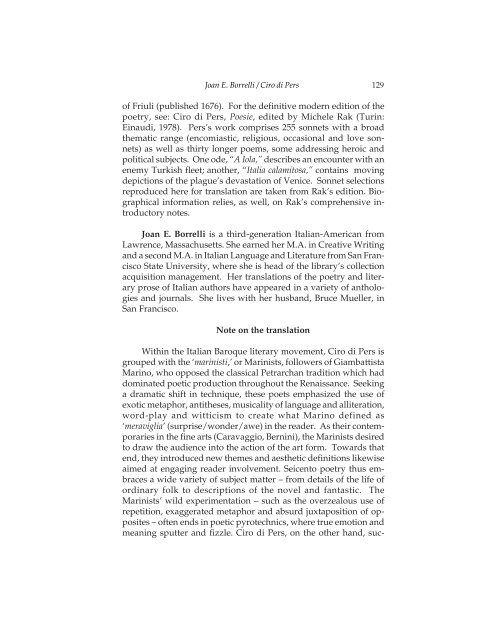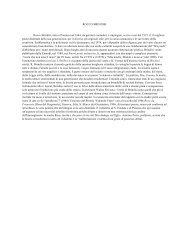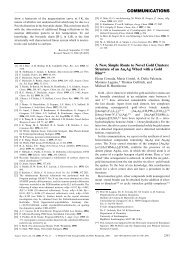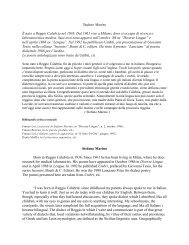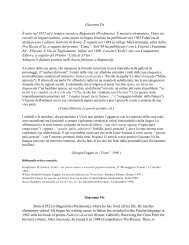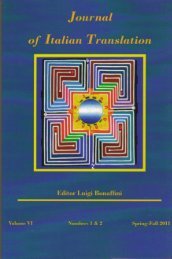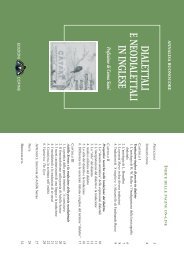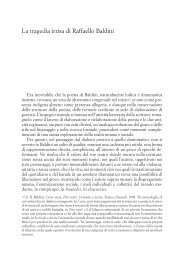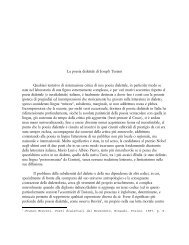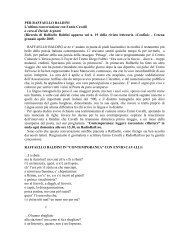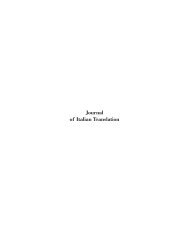Journal of Italian Translation - Brooklyn College - Academic Home ...
Journal of Italian Translation - Brooklyn College - Academic Home ...
Journal of Italian Translation - Brooklyn College - Academic Home ...
Create successful ePaper yourself
Turn your PDF publications into a flip-book with our unique Google optimized e-Paper software.
Joan E. Borrelli / Ciro di Pers<br />
129<br />
<strong>of</strong> Friuli (published 1676). For the definitive modern edition <strong>of</strong> the<br />
poetry, see: Ciro di Pers, Poesie, edited by Michele Rak (Turin:<br />
Einaudi, 1978). Pers’s work comprises 255 sonnets with a broad<br />
thematic range (encomiastic, religious, occasional and love sonnets)<br />
as well as thirty longer poems, some addressing heroic and<br />
political subjects. One ode, “A Iola,” describes an encounter with an<br />
enemy Turkish fleet; another, “Italia calamitosa,” contains moving<br />
depictions <strong>of</strong> the plague’s devastation <strong>of</strong> Venice. Sonnet selections<br />
reproduced here for translation are taken from Rak’s edition. Biographical<br />
information relies, as well, on Rak’s comprehensive introductory<br />
notes.<br />
Joan E. Borrelli is a third-generation <strong>Italian</strong>-American from<br />
Lawrence, Massachusetts. She earned her M.A. in Creative Writing<br />
and a second M.A. in <strong>Italian</strong> Language and Literature from San Francisco<br />
State University, where she is head <strong>of</strong> the library’s collection<br />
acquisition management. Her translations <strong>of</strong> the poetry and literary<br />
prose <strong>of</strong> <strong>Italian</strong> authors have appeared in a variety <strong>of</strong> anthologies<br />
and journals. She lives with her husband, Bruce Mueller, in<br />
San Francisco.<br />
Note on the translation<br />
Within the <strong>Italian</strong> Baroque literary movement, Ciro di Pers is<br />
grouped with the ‘marinisti,’ or Marinists, followers <strong>of</strong> Giambattista<br />
Marino, who opposed the classical Petrarchan tradition which had<br />
dominated poetic production throughout the Renaissance. Seeking<br />
a dramatic shift in technique, these poets emphasized the use <strong>of</strong><br />
exotic metaphor, antitheses, musicality <strong>of</strong> language and alliteration,<br />
word-play and witticism to create what Marino defined as<br />
‘meraviglia’ (surprise/wonder/awe) in the reader. As their contemporaries<br />
in the fine arts (Caravaggio, Bernini), the Marinists desired<br />
to draw the audience into the action <strong>of</strong> the art form. Towards that<br />
end, they introduced new themes and aesthetic definitions likewise<br />
aimed at engaging reader involvement. Seicento poetry thus embraces<br />
a wide variety <strong>of</strong> subject matter – from details <strong>of</strong> the life <strong>of</strong><br />
ordinary folk to descriptions <strong>of</strong> the novel and fantastic. The<br />
Marinists’ wild experimentation – such as the overzealous use <strong>of</strong><br />
repetition, exaggerated metaphor and absurd juxtaposition <strong>of</strong> opposites<br />
– <strong>of</strong>ten ends in poetic pyrotechnics, where true emotion and<br />
meaning sputter and fizzle. Ciro di Pers, on the other hand, suc-


